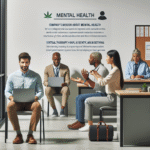
Breathe Easy: Essential Quick Stress-Relief Techniques for the Busy Professional
In the fast-paced world we live in, stress has become an everyday companion for many busy professionals. You may find yourself racing against deadlines, juggling meetings, and fielding a constant stream of emails and messages. This chaos can take a toll on your mental and physical well-being. However, the good news is that you don’t need to schedule an entire day of relaxation to alleviate stress. Instead, you can breathe easy with quick and efficient stress-relief techniques that fit seamlessly into your hectic lifestyle.
Understanding Stress and Its Impacts
Stress is not merely an emotional state; it has significant physical repercussions as well. Chronic stress can lead to health issues such as heart disease, obesity, diabetes, and even mental health disorders like anxiety and depression. The workplace is a primary source of stress for many, making it crucial to implement effective stress-relief strategies.
The Science of Stress
Understanding the physiological response to stress can motivate you to implement quick relief techniques. When you encounter a stressor, your body enters a "fight-or-flight" mode, releasing adrenaline and cortisol. These hormones prepare you for action, but prolonged exposure can lead to negative health effects. Implementing stress-relief techniques can help to reset your body’s response.
The Busy Professional Dilemma
As a busy professional, finding time for stress relief can feel impossible. Conventional methods often require time and space that you may not have. However, Breathe Easy: Quick Stress-Relief Techniques for the Busy Professional focuses on efficient practices you can incorporate into your daily routine.
Quick Stress-Relief Techniques
1. Deep Breathing Exercises
Deep Breathing is one of the simplest yet most effective techniques. This exercise activates your body’s relaxation response, reducing stress and anxiety almost instantly.
How to Do It:
- Find a quiet place or simply sit at your desk.
- Inhale deeply through your nose for a count of four.
- Hold your breath for four counts.
- Exhale slowly through your mouth for a count of six.
- Repeat this cycle for five minutes.
Benefits:
- Reduces heart rate and blood pressure.
- Enhances concentration.
- Promotes a sense of calm.
2. Progressive Muscle Relaxation (PMR)
Progressive Muscle Relaxation focuses on tightening and then relaxing different muscle groups in your body.
How to Do It:
- Sit comfortably in a chair or lie down.
- Start with your toes: clench them tightly for five seconds, then release.
- Move up through your legs, abdomen, arms, and face, repeating the clenching and relaxing.
- Take a deep breath in between muscle groups.
Benefits:
- Helps identify and minimize muscle tension.
- Encourages mindfulness and focus.
3. Mindfulness Meditation
Mindfulness is about being fully present in the moment without judgment. Practicing mindfulness can ease the burden of stress.
How to Do It:
- Sit comfortably and close your eyes.
- Focus on your breath, noting the rise and fall of your chest.
- If your mind wanders, gently guide it back to your breath.
- Practice for just five minutes.
Benefits:
- Increases focus and cognitive flexibility.
- Reduces anxiety and stress.
4. Quick Physical Movements
Incorporating physical movements into your day can serve as an effective stress reliever.
Suggestions:
- Stand up and stretch for one minute.
- Do a set of desk push-ups or squats during breaks.
- Take a brisk walk around the office or outside.
Benefits:
- Releases endorphins, improving your mood.
- Enhances physical health and energy.
Real-World Case Studies
Case Study 1: Implementing Workplace Wellness Programs
A prominent tech company recognized the high stress levels in their workforce and decided to implement wellness programs focusing on quick stress-relief techniques. They encouraged deep breathing exercises during team meetings and organized mindfulness sessions for employees.
Analysis: The result was a noticeable decrease in reported stress levels, increased productivity, and greater employee satisfaction. This showcases how Breathe Easy: Quick Stress-Relief Techniques for the Busy Professional can manifest in a corporate setting, improving the overall work culture.
Case Study 2: The Impact of Short Breaks
A healthcare provider noticed that their staff exhibited signs of burnout. They began encouraging short breaks every hour, promoting physical movements and deep breathing exercises.
Analysis: The feedback was overwhelmingly positive. Employees reported feeling refreshed and more focused after these breaks. This highlights the effectiveness of integrating simple techniques into the workday to combat stress.
The Role of Environment in Stress Management
The environment in which you work plays a significant role in your stress levels. A cluttered desk, inadequate lighting, and noise can amplify stress. Consider taking the following steps:
- Organize Your Workspace: A tidy space can reduce stress and improve focus.
- Incorporate Nature: Bringing plants into your office can enhance feelings of well-being.
- Adjust Lighting: Use natural light whenever possible; it’s known to enhance mood and productivity.
Creating a Stress-Relief Toolkit
One of the best ways to ensure you’re always prepared to tackle stress is to create a personalized stress-relief toolkit. Here are some components to consider for your toolkit:
| Tool | Purpose |
|---|---|
| Breathing App | Guided breathing exercises |
| Essential Oil Roller | Aromatherapy for instant calm |
| Stress Ball | Physical outlet for tension |
| Quick Relaxation Guide | A printed list of techniques |
| Personal Journal | Space to vent and reflect |
Conclusion: Breathe Easy and Thrive
Incorporating quick stress-relief techniques into your busy lifestyle doesn’t just reduce stress; it enhances your productivity and overall well-being. By practicing techniques like deep breathing, mindfulness, and engaging in physical activity, you can effectively manage stress. Remember, adopting a few strategies from Breathe Easy: Quick Stress-Relief Techniques for the Busy Professional can make all the difference in maintaining your health and vitality.
Actionable Insights
- Dedicate at least five minutes each day to practice one of the techniques discussed.
- Create a stress-relief toolkit tailored to your daily challenges.
- Make a commitment to prioritize your mental health amidst professional responsibilities.
FAQs
1. How often should I practice stress-relief techniques?
Aim to practice your chosen techniques daily. Even short, five-minute sessions can have a significant impact over time.
2. Can deep breathing really reduce stress quickly?
Yes, deep breathing exercises trigger the relaxation response, often leading to immediate reductions in stress levels.
3. What if I don’t have time for long meditation sessions?
Even a few minutes of mindfulness can be effective. Focus on your breath and let your thoughts float away without judgment.
4. How do I stay motivated to practice these techniques regularly?
Set reminders on your phone or have a designated spot in your workplace for your stress-relief toolkit to ensure easy access.
5. What should I do if stress persists despite these techniques?
If stress remains overwhelming, consider consulting with a mental health professional for tailored strategies and support.
By incorporating these simple yet effective techniques into your day, you can learn to navigate stress effortlessly—ensuring you not only survive but thrive in your professional life. Breathe easy and embrace the calm!











